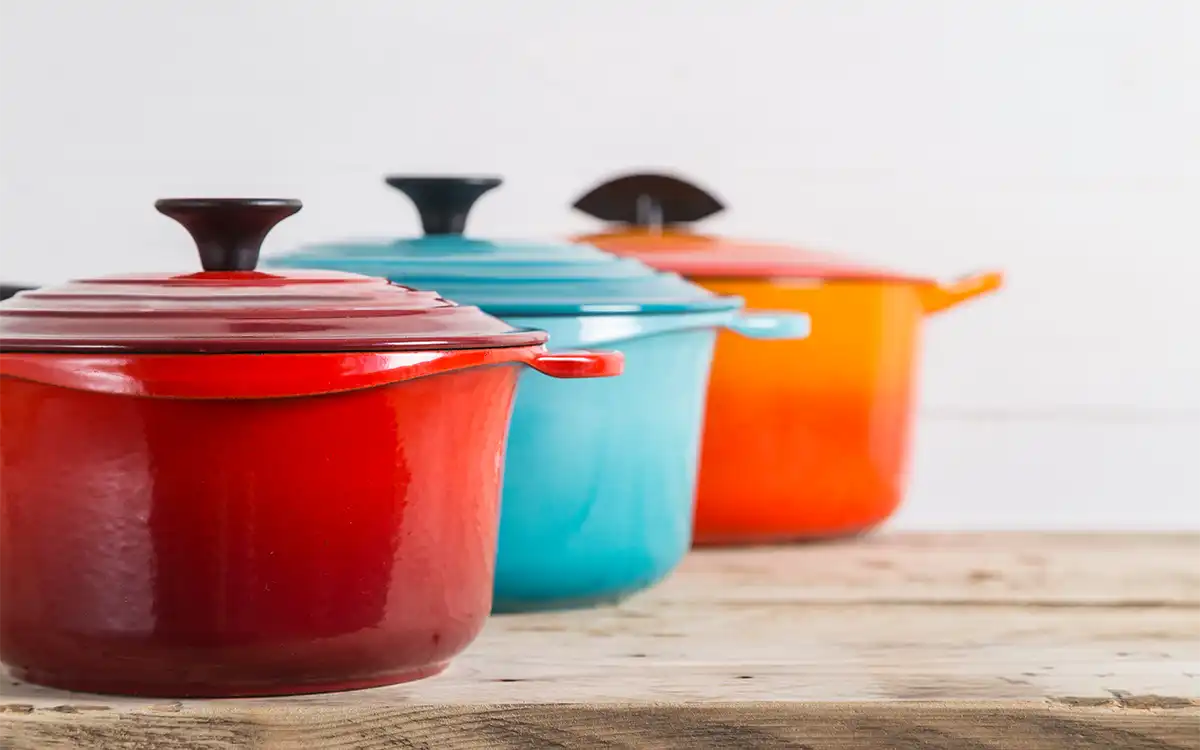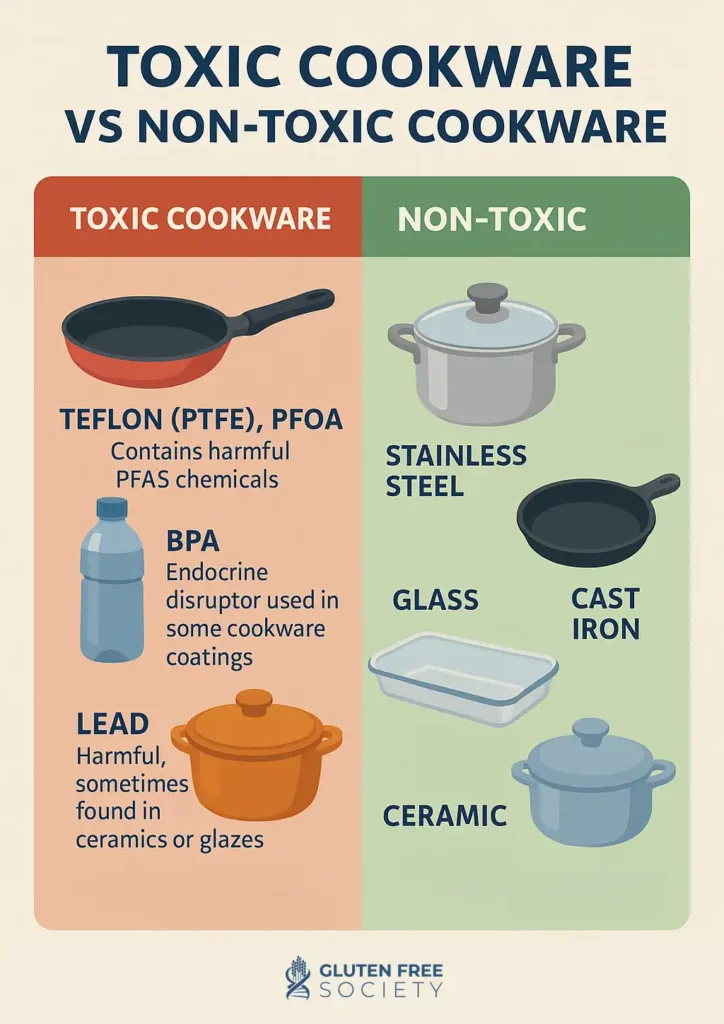new to the gluten free journey?
new to the gluten free journey?

Cooking at home helps to give you full visibility into the ingredients in your meals, and ensure that they are 100% gluten free. Making your own food can provide a sense of certainty and comfort. However, just as it is important to choose high quality gluten free ingredients for your meals, it is also important to choose high quality and safe cookware to prepare your meals.
While it would be wonderful to trust that all cookware is free from toxic chemicals and gluten, the reality is that many types of cookware are not. In an effort to make cookware nonstick (thanks in part to an unfounded fear of fat) and also able to handle modern day conveniences like dishwashers, many different types of cookware materials have flooded the market, and many of them are simply not good for our health.
Unfortunately, many of these materials contain substances that are toxic for our health. We’ll dig in more as to why later in this article, as well as share options for safe, non-toxic cookware to make your kitchen complete.
As with all of our content, please know that we are not sharing this information to invoke fear or guilt. Instead we are sharing this to inform you and guide you in making safe cookware choices.
Contents
ToggleThere are several potentially toxic materials that can be found in cookware that we will discuss below:
The bottom line is that PFOAs, PTFEs, and PFAS are all harmful to health and should be avoided in cookware and other products you use.

Just as it is important to stick to a gluten free diet, it is important to prepare your foods using only gluten free cookware (as well as appliances and utensils that are free from gluten. Most cookware is naturally gluten free, and research has shown that gluten is effectively eliminated from cookware when it is cleaned thoroughly with soap and water.
One exception to this is cast iron. Since cast iron is more porous, it has the potential to retain gluten and cause cross contamination of gluten, even after cleaning. It is best to have a dedicated gluten free cast iron pan when preparing food, or if someone else is preparing food for you.
As with any gluten free food preparation or purchase, it is important to be mindful of cross contact or cross contamination, and to educate others in your household about how to properly maintain a kitchen that is safe for everyone. Cross contamination can happen easily when sharing cookware or utensils if they are not properly cleaned. For example, a cutting board that was used for bread should be washed thoroughly before using it to cut vegetables for a gluten free meal. A measuring cup that is used to scoop into a bag of gluten containing flour should be immediately set aside to wash, not used to dip into a bag of shared sugar.
Note that cross contamination can also happen with appliances and condiments or other ingredients when cooking. For example, if someone uses a knife to butter bread and “double dips” onto the bread and back into the butter, that butter is contaminated. If a gluten free eater dipped into the butter to add to a skillet with eggs, they could be exposed to gluten. Small appliances like toasters and waffle irons that are difficult to clean should be dedicated gluten free.
Dedicating only one area of your kitchen as the “gluten counter” or “gluten space” can help contain gluten and prevent cross contamination. If other household members or guests have gluten at the same meal as you (for example, bread or rolls at dinner), keep them off the table, only in the gluten area of the kitchen. If serving family style, have other members fill their plates first with gluten-free food and then visit the gluten area to get gluten-containing food. When getting second helpings, it’s wise to get a new plate. Get everyone in the habit of washing hands both before and after meals.
The good news is that there are several options for non-toxic cookware. Each has its strengths and considerations, and we will discuss them all below so that you feel informed and empowered when considering which cookware makes sense for your kitchen.
Despite the name, ceramic cookware doesn’t actually contain ceramic. Instead, ceramic cookware is made from a metal base and coated with a water- and oil-resistant coating that is made from silicon oxide (also known as silica). The name “ceramic” comes from the coating’s glossy, enamel-like appearance.
Ceramic cookware is often marketed as a safer, more sustainable alternative to regular, coated nonstick cookware, and the pros of ceramic cookware are similar to those of regular nonstick cookware. The smooth nonstick finish requires less oil or cooking fat to keep food from sticking, and it also allows for easier cleanup. And unlike traditional nonstick cookware, it does not contain the toxic coating that can leach into your food.
However, as nice as ceramic cookware sounds, it doesn’t come without some cons. For example, it tends to be more delicate and not as durable as other types of cookware. Many ceramic pans are made with a non-anodized aluminum base, which can warp and scratch more easily. The coating is delicate, too. Even high quality ceramic cookware is only likely to last a couple of years. This is because the silicon oxide coating naturally releases every time you heat up your pan, and once that coating has worn out, the pan will no longer be nonstick.
Ceramic cookware is trendy right now, so you will likely see several options on shelves (and in your internet ads). Be sure that yours is free from PTFE, PFAS, and PFOA, as well as lead and cadmium. If the website or packaging materials don’t tell you what you need to know, don’t hesitate to reach out to the company and ask.
Cast iron cookware has been around for centuries, which is probably an indication of its quality. Cast iron is incredibly durable and safe, but it does require some attention and care to keep it in good shape. You will need to use plenty of a high quality heat stable oil (like coconut, avocado, or tallow) to prevent sticking and keep it seasoned. When cleaning, be sure to wash gently and then put over low heat to dry so that it does not retain moisture that causes it to rust.
Cast iron is made of iron, so it can actually increase the iron content of your food. As low iron is common in those with celiac disease due to malabsorption, additional iron is especially beneficial for those who are still restoring their nutrient levels following a celiac disease diagnosis.
Cast iron cookware typically comes “pre seasoned” meaning it has been treated with oil to help protect its properties. It is important to check your cast iron before purchasing to be sure that it was not seasoned with any ingredients that contain gluten.
Stainless steel is an alloy, or mixture, of several metals. Stainless steel cookware is made from iron, prized for its strength and longevity, and is mixed with small amounts of other metals, mainly chromium and trace amounts of carbon, manganese, copper, and nickel.
All stainless steel cookware is required to have a minimum of 16% chromium to ensure the highest corrosion resistance for safety reasons. Within food-grade stainless steel, The NSF requires manufacturers to adhere to the guidelines of either 200, 300, or 400 series (200 and 300 make up the vast majority of stainless cookware). 200 series stainless steel is the lowest grade and is usually found in cheaper, lower-quality cookware. The 300 and 400 grades are higher quality.
Stainless steel cookware is loved by chefs for its durability and excellent heat distribution. It is resistant to warping, denting, and scratching. It is safe to use on stovetops and in the oven, and it is non reactive, so it is safe to use with acidic ingredients like lemon juice. Stainless steel cookware truly is an investment as it will last for several years with proper care. Because it is not treated with any chemicals or seasonings, it is also nontoxic and gluten free.
However, stainless steel cookware is not foolproof. Since it is not nonstick, it requires the use of enough fat (oil, butter, tallow, etc.) in order to prevent sticking. or steaming, of course). Because of this, and because of how hot it can get, there can be a bit of a learning curve when adjusting to using stainless steel cookware in your kitchen.
There are three types of glass used in the kitchen. All are produced a bit differently for different applications, and all are non-toxic.
Of course, all glass is more fragile than many other types of cookware, so it is important to understand where you can use it and how to handle it safely. Glass cookware cannot be used on the stovetop. It is best used for baking in the oven. Glass is also great for things like liquid measuring cups and mixing bowls. Unlike other types of cookware, glass can be cleaned in the dishwasher.

Choosing and maintaining non-toxic cookware might feel overwhelming, so here are some tips:
Remember, if the website or packaging materials don’t tell you what you need to know, don’t hesitate to reach out to the company and ask.
In addition to the health considerations of cookware, it is worth considering the environmental impact of your cookware. We list the implications for each type of cookware below:
There are so many different brands that manufacture and sell cookware and it can feel overwhelming to sort through the best options. We are taking some of the guesswork out of the process by sharing some of our favorite brands and products:
If your budget and kitchen space allows, having a variety of types of cookware can be helpful. Not only can you match the type of pan to the type of dish you are cooking, you can also cook multiple dishes at a time without having to wash the cookware between uses. For example, you might be making a stir fry with chicken and vegetables in one skillet and cauliflower rice in another skillet. A large stainless steel skillet would be perfect to pan fry the stir fry, and a smaller cast iron or ceramic skillet would work well for cauliflower rice.
Cooking at home is a wonderful way to support your health, especially when you have specific needs, like a strict gluten free diet. However, just as it is important to choose high quality healthy ingredients for your meals, it is also important to choose high quality and safe cookware to prepare your meals. We hope you feel empowered to make informed decisions for a healthy kitchen to support your healthy life! Now check out our phenomenal chef inspired gluten free recipe library and cook away.
Choosing appropriate cookware is crucial in a gluten-free kitchen to prevent cross-contact with gluten. Certain materials can harbor gluten residues, which may contaminate gluten-free foods and pose health risks for individuals with celiac disease or gluten sensitivity.
Stainless steel, pure ceramic, and high-quality cast iron are considered safe options for gluten-free cooking. These materials are non-porous and, when properly cleaned, do not retain gluten residues. It’s essential to ensure that cast iron cookware has not been previously used with gluten-containing foods, as its porous nature can absorb gluten.
Non-stick pans are not recommended. Aside from containing toxic chemicals, these pans are prone to scratching. Scratches can trap gluten particles, leading to cross-contact.
Yes, it’s advisable to replace wooden utensils and cutting boards, as wood’s porous nature can harbor gluten particles even after thorough cleaning. Opt for materials like silicone, plastic, or stainless steel for utensils, and consider using non-porous cutting boards made of plastic or tempered glass.
It’s recommended to have separate colanders and sifters for gluten-free cooking. The small holes in these tools can trap gluten residues, making them difficult to clean thoroughly and increasing the risk of cross-contact.
In a shared kitchen, consider the following measures to prevent cross-contact:
Use separate cookware, utensils, and appliances for gluten-free cooking.
Store gluten-free items separately from gluten-containing foods.
Clearly label gluten-free equipment and areas.
Clean all shared surfaces and equipment thoroughly before preparing gluten-free foods.
Implementing these practices helps maintain a safe environment for gluten-free cooking.
Yes, several brands focus on producing non-toxic cookware suitable for gluten-free kitchens. For instance, Caraway offers ceramic-coated aluminum cookware free from harmful chemicals like PTFE and PFOA. More brand options are listed above.
Stay up-to-date with the latest articles, tips, recipes and more.

*These statements have not been evaluated by the Food and Drug Administration. This product is not intended to diagnose, treat, cure or prevent any disease.
If you are pregnant, nursing, taking medication, or have a medical condition, consult your physician before using this product.
The entire contents of this website are based upon the opinions of Peter Osborne, unless otherwise noted. Individual articles are based upon the opinions of the respective author, who retains copyright as marked. The information on this website is not intended to replace a one-on-one relationship with a qualified health care professional and is not intended as medical advice. It is intended as a sharing of knowledge and information from the research and experience of Peter Osborne and his community. Peter Osborne encourages you to make your own health care decisions based upon your research and in partnership with a qualified health care professional.
2 Responses
Much ❤️
Dr Osborne.
great day, thank you very much for taking all of the guesswork out for me. It was truly hard to know what is best to used, I am truly grateful for your care in educating us in this massive world off greed hungry uncaring persons. Thanks